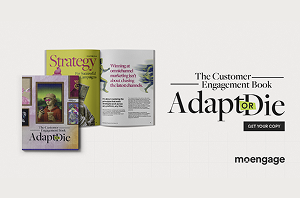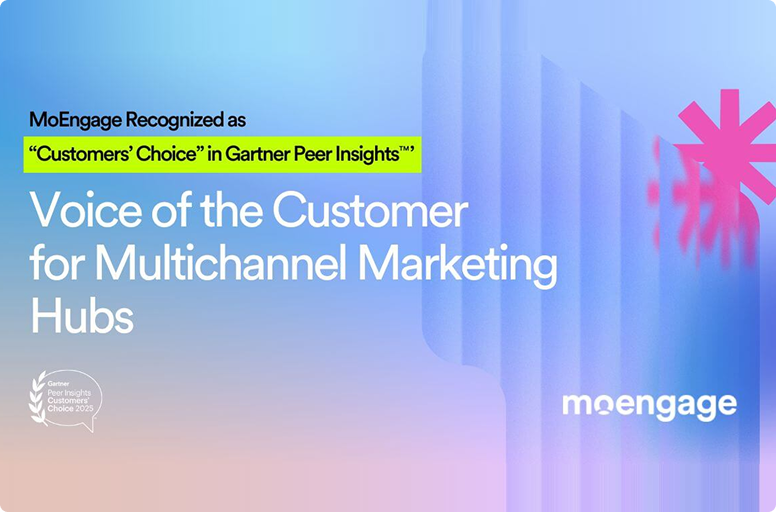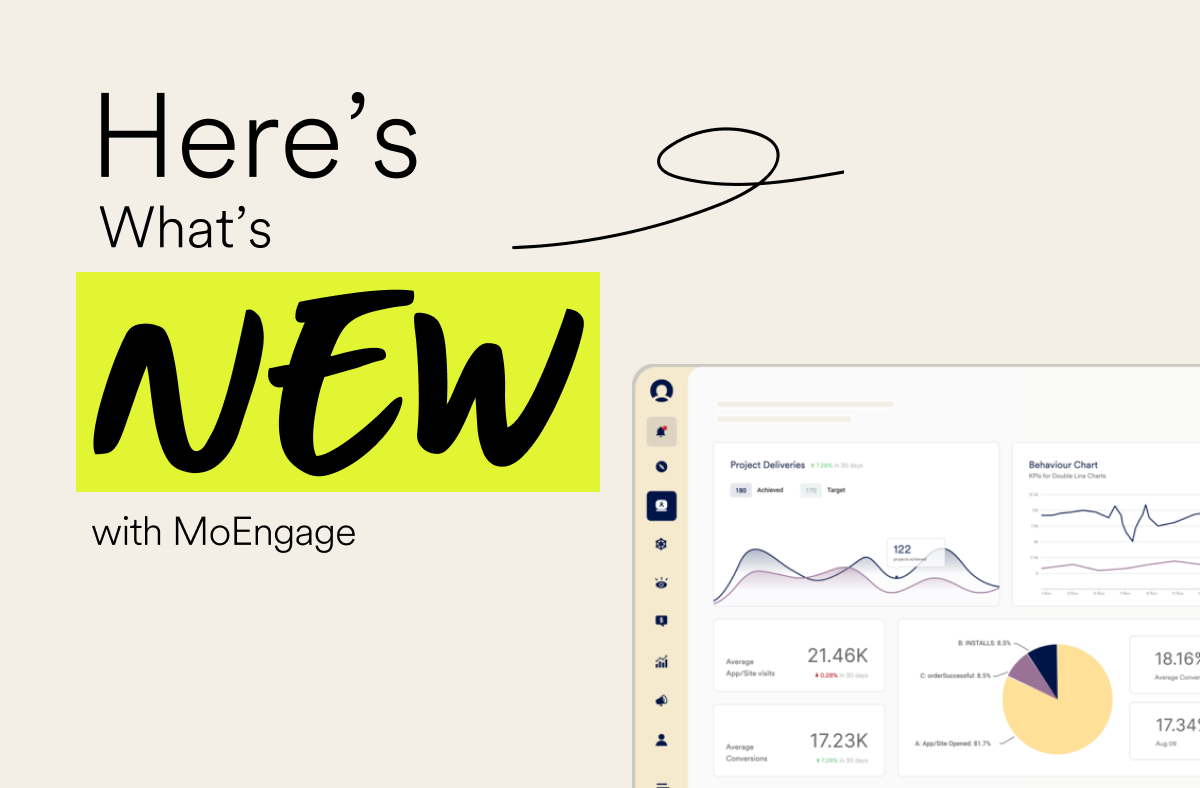Personalized Marketing: What It Is, Why It Matters, + Key Metrics
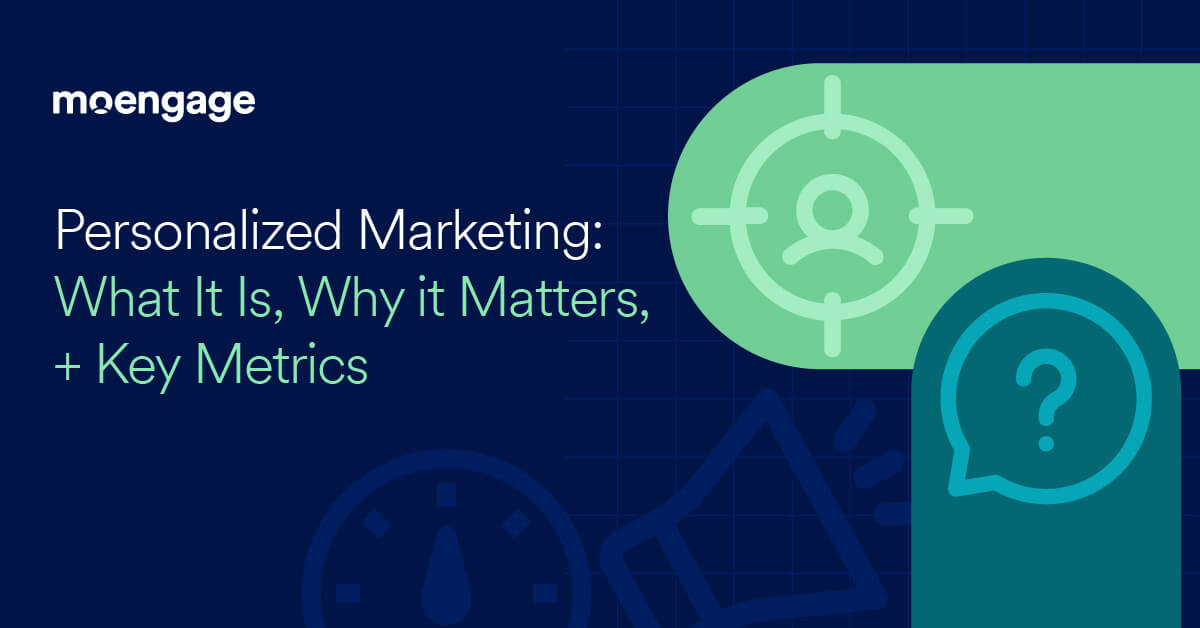
Reading Time: 15 minutes
In the ever-evolving world of B2C marketing, where consumer trends change at the blink of an eye, advertisements and messages often get lost in the overwhelming sea of communications.
If you’re serious about leaving a lasting impression and forging meaningful connections with your customers, it’s essential to go the extra mile. The key lies in capturing their attention with personalized marketing that resonates with them and addresses their specific desires and needs.
By taking this approach, you’ll not only differentiate yourself from the competition but also create a bond that goes beyond a mere transaction. Now is the perfect moment to leave your mark and ensure that your customers feel genuinely acknowledged and comprehended.
Whether you’re new to personalized marketing or you’re trying to perfect your strategies to squeeze out the maximum level of engagement, retention, and revenue, we’ll help you by giving you an in-depth overview in this blog.
Let’s dive in.
What is Personalized Marketing?
Personalized marketing refers to tailoring marketing efforts to meet individual customer preferences, behaviors, and needs. Its significance lies in its ability to cut through the noise and connect with prospective customers on a deeper level, which will improve overall conversions.
According to our North American Personalization Pulse Check 2023 Report, 56% of consumers expect a curated shopping experience from the brands they shop from regularly. And most marketers are meeting that demand, with 89.9% of markers using some form of personalization in their cross-channel marketing campaigns.
The fact is, leading marketers are using personalization to stay ahead of the competition and offer incredible, seamless experiences to their customers. If you aren’t doing it, you’re likely falling behind.
As consumer expectations evolve, so does the importance of these personalized marketing trends and experiences, making it an integral strategy for customer retention and engagement.
While it may seem straightforward, personalized marketing relies on piecing together a number of core strategies and tactics, including:
1. Customer Profiling
Segment customers and develop common buyer personas based on demographics, purchase history, personal preferences, and behavioral patterns. The more granular you get, the more unique personas you can develop, allowing you to provide diverse personalization campaigns with deeper levels of customization.
2. Content Personalization
Don’t just swap out their name in a templated email, offer customers truly customized content that’s relevant to them based on their personal preferences and past behavior. This goes for website landing pages, email content and subject lines, push notifications, and SMS messages. When the content and communication customers receive matches their interests, preferences, and past purchases, it’s far more likely to drive engagement and conversions.
3. Omnichannel Marketing
Omnichannel marketing isn’t just about providing a consistent, seamless experience across all of your channels. It’s also an incredible personalization tool that allows you to customize where you communicate with your customers for better traction and engagement. Messaging customers on their preferred channels increases open rates, engagement metrics, and builds brand loyalty, all of which increase conversions and revenue.
4. Customer Journey Mapping
Success in personalized marketing is all about finely tuning what, where, when, and how you communicate with your customers. And there’s no better way of doing that than by fully understanding every touchpoint along your customer journey pathways. This allows you to identify strengths and weaknesses, and then deploy the right strategies for the greatest impact.
5. Upselling & Cross-Selling
Without personalizing your upselling and cross-selling efforts, you’re really just taking a shot in the dark. Serving relevant product recommendations allows you to drastically increase your chances of success by increasing AOV and LCV. Engaging with your customers after the initial sale — or even during — is a great way to increase retention and revenue.
6. Real-Time Responsiveness
The ability to serve personalized content based on real-time actions puts you in the driver’s seat, empowering you to steer your customers along (or back onto) the optimal customer journey pathway. Responsive, personalized marketing efforts that trigger in real-time allow you to serve contextual advertisements and messaging to customers based on their geographic location, recent purchase activity, or other user signals.
7. Social Media Monitoring
Consumers are spending more time on social media, and doing more of their browsing (and even shopping) there. But more than that, it’s a place where customers are candid about their experiences with brands. Monitoring social media can provide a wealth of insights into customer sentiment, brand recognition, individual feedback, and overall trends that you should be aware of.
Why is Personalization Important in Marketing?
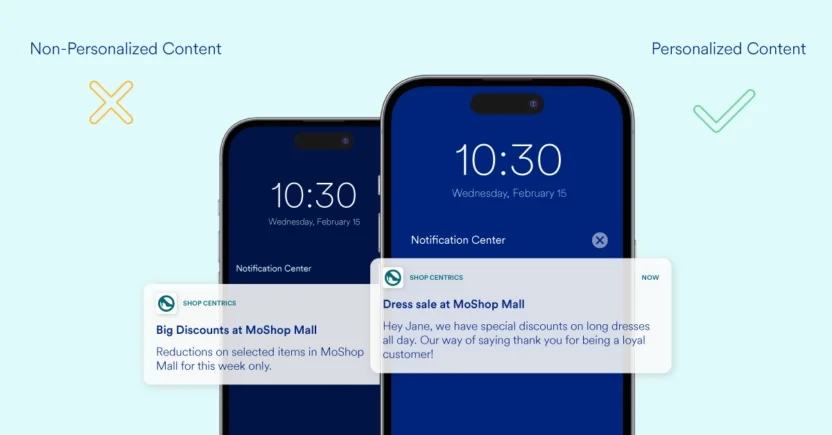
Modern consumers don’t just enjoy personalization, they now expect it.
According to McKinsey & Company, 71% of consumers expect the businesses they buy from to personalize their product recommendations and communications. And 76% of customers say they are dissatisfied with a business if they don’t get the expected level of personalization, which can lead them to look elsewhere.
With customers demanding this level of customization, marketers must provide this to retain customers and increase brand engagement.
Fortunately, personalized marketing comes with a wealth of benefits that help drive engagement, retention, and conversions:
- Higher conversion rates: Getting the right message, on the right channel, at the right time significantly improves the likelihood of a sale.
- Improved customer satisfaction: Personalization allows you to give customers an optimal experience, improving overall satisfaction with your product and brand.
- Increased customer engagement: Better communication increases traction and engagement with customers.
- Enhanced customer loyalty: Building a meaningful, personal relationship with your customer fosters loyalty with your products, services, and brand.
- Reduce cart abandonment: By bringing more customers back into the purchase funnel and driving them to complete their orders, fewer customers abandon their carts.
- Decrease marketing spend: By retaining customers and increasing their average spend, customer acquisition and marketing costs generate far more value.
- Increased ROI: Successful personalization increases engagement, retention, and conversions, leading to greater ROI and increased revenue.
The fact is, personalized marketing increases engagement and improves retention, leading to more conversions and higher revenue.
How to Build a Personalized Marketing Strategy
Your results will only be as good as your planning allows. Follow the steps below to build and manage an effective personalized marketing strategy; one that fosters customer engagement and brand loyalty.
1. Collect and Analyze Customer Data
The foundation of any personalization efforts will rely on the data you’re able to collect, marshal, and leverage. The more data you have, the more informed your decisions will be, grounding your analysis in fact (rather than instinct and bias).
Your ability to personalize marketing strategies and messages relies solely on your ability to leverage personal data in a meaningful, constructive way that improves the customer experience and engagement.
2. Segment Customers for Focused Targeting
The more ways you can segment customers, the more marketing strategies you’ll unlock. Perfecting personalized marketing isn’t about just finding your ideal customer, it’s about understanding the different customer personas you have and finding the best way to increase engagement with each of these segments.
When thinking about personalization, there are a few different types of segmentation that can be useful for optimizing your personalization efforts.
- Demographic segmentation: This involves breaking customers down by some of their most basic measurable characteristics, such as their age, gender, education, income, marital status, occupation, and geographic location.
- Psychographic segmentation: This involves breaking customers down based on psychological and lifestyle attributes, such as personality traits, beliefs, values, interests, hobbies, attitudes, and opinions.
- Behavioral segmentation: This involves breaking customers down based on their past behavior and actions, such as their engagement history, purchase history, usage patterns, and other behavioral data.
The more data you have, the more granular you can be with your segmentation, allowing you to focus your personalization efforts, driving traction, engagement, and conversions.
3. Serve Dynamically Personalized Content
Customers don’t just want a ‘personalized’ message that addresses them by name but lacks any other real value. Instead, they want dynamic personalization that enhances their user experience and improves satisfaction.
This means serving dynamically personalized experiences at as many customer touch points as possible, including website and landing page content, email and newsletter campaigns, and push notifications and SMS messages.
4. Target Product Recommendations to Upsell and Cross-Sell Effectively
Personalized product recommendations can drastically improve the impact of your upselling and cross-selling strategies, garnering better traction and leading to more sales.
Don’t just recommend products at random. Use collaborative filtering algorithms and recommendation engines that are designed to suggest products and services to customers based on their past purchases, preferences, and behavior. You can even use the behavior of similarly segmented customers to inform how to market other customers that have the same characteristics.
When done properly, personalized product recommendations can allow you to increase your average order value, customer lifetime values, and your overall revenue.
5. Provide Personalized Promotions, Discounts, and Offers
How often do you find now-expired coupons tucked away in a drawer, coupons that were never used because they were given to you at the wrong time, didn’t cover a service you that fit your needs, or weren’t even available in your geographic location?
Don’t just send promotional campaigns that you hope will stick. Get more value out of your promotional campaigns by using targeted, personalized marketing strategies.
Use trigger-based marketing that automatically sends customers offers that are relevant to their recent activity and behavior. For example, you can give customers a welcome reward of $5 after they’ve fully completed registration or send a discount code for a certain product category when a customer abandons their cart to encourage them to return and complete the buying process.
Implement behavioral-based discounts and coupons as well, tailoring discounts based on previous interactions, purchase history, and engagement with your brand. This will motivate existing and potential customers to purchase (or even repurchase). For example, a customer that continuously has only ever purchased adult movie tickets is unlikely to be interested in a family bundle for 2 adults and 2 children.
Personalized discounts and offers don’t just increase the likelihood of your customers using the offer and converting; they also provide a better experience and incentivize them to return to your store the next time they’re shopping.
6. Create Personalized Social Media Ads
Modern consumers are inundated with social media ads. This overload means messages that aren’t relevant get lost in the haystack.
Personalized marketing allows you to develop customized social media advertisements based on the customer segments you’ve identified and the personas you’ve modeled. Targeted advertisements directed at particular groups of people ensure every ad you serve is relevant, drastically improving click-through rates and conversions.
How to Automate Personalization in Marketing
Most marketers fear that personalization is extremely time-consuming, requiring interacting with customers on a one-to-one basis. Modern personalized marketing solutions empower teams to automate most of these efforts though, allowing your team to drive engagement at scale.
To get personalization right in marketing, brands need to get three things right:
- Segment your audience
- Determine the proper content & channel
- Perfect your timing
Let’s explore each in more detail.
1. Segment Your Audience
The more customers you have, the more diverse your audience becomes. They are looking for different products, services, and experiences, making it challenging to meet each of their unique needs at once. But even for small organizations, it’s essential to segment customers when attempting to offer personalized marketing.
Customer segmentation allows you to understand what different customers want, rooted not just in instinct, but based on demographics, spending behavior, and other factual data that backs it up.
MoEngage’s AI engine, Sherpa, leverages data on customer demographics, lifestyle choices, behavior, location, and more to ensure it optimizes personalized marketing campaigns based on engagement data, not on a whim.
2. Determine the Proper Content & Channel
Most marketers choose the delivery channel that’s optimal for their own team to manage, when they should instead be attempting to reach their customer via the customer’s preferred channel. Even the best content is no good if your customers aren’t reading it or engaging with it.
Segmented data will help you understand which channel customers prefer, and will allow you to communicate with them via their preferred method, increasing the chances your content is not only viewed, but also clicked.
Not all customers will connect with the same content. Entire campaigns and individual messages should be tailored toward specific segments you’re sending messages to optimize read-through, click-through, and engagement rates.
Sherpa tests multiple customer journeys, identifying the best-performing pathways and automatically improving them for enhanced performance. It also optimizes content for better traction and higher conversions.
3. Perfect Your Timing
The timing of your message isn’t just about optimizing open and click-through rates, it’s also about making sure your message is even seen in the first place.
Perfecting the timing of your advertising, remarketing, and abandonment campaigns shouldn’t be determined by what best suits your organization; it should be guided by engagement metrics that dictate when customers want to receive communication. This can even mean sending different types of messages, via different channels, at different times of the day.
Sherpa analyzes customer behavior to understand what times of day customers prefer to get messages, increasing not only the delivery rate but also impact and engagement.
How Personalization in Marketing Affects Conversion
We’re all looking to get to conversions, and while we want to close the deal as fast as possible, there are a lot of steps that come first — especially if you’re looking to foster long-term success.
More than anything, personalization is meant to make you more appealing to your customers. Although the end goal is that this drives conversion, the direct objective is actually to improve customer satisfaction, which initiates a domino effect that leads to increased engagement, retention, and finally conversions.
But when done properly, this will also allow you to build customer loyalty that doesn’t just mean a single sale, but repeat purchases that increase click-through rates, customer lifetime value (CLV), and overall revenue. Ultimately, it’s about using personalization to nurture customers at each point in the journey, increasing open rates, click-through rates, conversions, and even cross-selling.
9 Key Metrics to Evaluate Personalized Marketing Success
Personalized marketing is all about developed marketing that connects with your customers and drives engagement, retention, and conversions. But without the analytics to back it up, it’s hard to know which campaigns perform best.
What you may think of as your flagship campaign could be your third best performing, without you realizing it. A page you designed for conversion may be performing better when it comes to retention or lead-nurture than you originally planned. With data at your fingertips, you can understand what is (and isn’t) working, and adjust accordingly.
When analyzing your marketing funnel to see the performance of your personalization efforts, it’s good to look at the entire customer journey, and where to use each metric.

Below, we cover the top 9 metrics in detail to help you measure the performance of your personalized marketing strategies, campaigns, and overall efforts.
1. Open Rate / Impressions
The percent of sent messages or advertisements that are opened or viewed.
The open rate or impression rate indicates how well customers are engaging with your marketing campaigns, whether that’s via email, SMS, push notifications, social media content, or digital advertising.
The open rate formula is:

It’s difficult to sell to customers if they never walk through the front door. Open rates provide an indication of how successful your top-of-funnel lead generation efforts are by measuring the impressions and open rate of advertisements and messages. Personalized marketing should help you gain traction at these stages, ensuring more customers proceed further along in their shopping journey.
2. Click-Through Rate (CTR)
The click-through rate (CTR) indicates how many times a user clicks a link from a website, email, or digital advertisement. It’s used as a measure of how successful a marketing campaign is at generating engagement.

When personalizing your marketing strategy, measuring the change in your click-through rate is a great way to understand how engaging your content is to your customers.
3. Cart Abandonment Rate
The percent of customers that leave an initiated shopping cart incomplete.
The cart abandonment rate indicates how many carts were abandoned after being opened. It’s an indication of how successful your checkout experience is.
The cart abandonment rate formula is:

The cart abandonment rate is a good indicator of how well your personalized marketing efforts are at driving customers through the checkout process. If your cart abandonment rate goes down, your personalization strategies are working effectively to retain customers and drive conversions.
4. Conversion Rate
The percent of customers that complete a conversion event.
The conversion rate indicates the success rate of different conversion events. Most commonly, this is used to track purchases, but it can also be used for a variety of other conversion events like newsletter signups, form completions, and other lead capture events.
The conversion rate formula is:

The conversion rate is a good indicator of how successful you are at selling your product compared to how many people are exposed to your product or service. For personalization marketing, it can be used to determine if your personalization efforts are more effective at converting customers and nurturing leads through the sales funnel.
While your conversion rate is an important metric, there are often a lot of steps before customers make a purchase. And one-time buyers aren’t nearly as valuable as repeat buyers. All that to say, many engagement and retention metrics are just as important — if not important — for understanding the health of your sales efforts as a whole, and your personalized marketing campaigns in particular.
5. Average Order Value (AOV)
The average value of a single order.
The average order value (AOV) indicates the average value of an order from your customers. Companies that sell subscription services may alternatively use Revenue Per Visitor (RPV). This is often used to analyze how valuable each conversion is, and can be used as a baseline to understand how much a customer is likely to spend.
The average order value formula is:

The average order value is an indicator of how valuable each individual transaction is. For personalization marketing purposes, it can be used to determine if your personalization efforts are helping you upsell or cross-sell. The higher your average order value rises, the more successful your personalization efforts are.
6. Repurchase Rate
The percent of customers that complete more than one purchase.
The repurchase rate indicates the number of customers that return to make repeat purchases. It’s used to measure how successful a company is at retaining customers, increasing lifetime customer value, and increasing revenue.

The repurchase rate is a good indicator of how well you are doing at retaining customers. Effective personalized marketing empowers teams to improve the repurchase rate, driving up average order values, lifetime customer value, and overall revenue.
7. Customer Retention Rate
The percent of customers that stay with your brand.
The customer retention rate indicates how many customers you’ve kept in a specified period. It’s a strong indicator of how well you are doing at engaging and retaining customers.
The customer rate formula is:

Flat out, your customer retention rate indicates exactly how many customers you’ve kept, and is a clear indicator of how well you do at keeping customers. Companies often make the mistake of prioritizing their customer acquisition over customer retention, when customer retention is a far more important indicator of long term growth and engagement.
8. Churn Rate
The percent of customers that abandon your brand.
The churn rate indicates how many customers you’ve lost in a specified period. This can be used to look at the total number of churned customers, or it can be used to analyze smaller customer segments. For example, you could look only at daily active users to see the churn rate on daily engagement.
The churn rate formula is:

In general, churn rate is an indicator that customers are dissatisfied with your product or service, and are leaving for an alternative. While churn rate doesn’t itself provide an answer as to why customers are leaving, it gives you a great place to start investigating. Figure out where customers are dropping off, and then improve that stage in the customer journey to improve traction and increase retention.
When implementing personalization strategies, churn rate is a good indicator of whether these efforts are successful or not.
Note: The churn rate is the inverse of the customer retention rate. You can also calculate it by subtracting the customer retention rate from 1.

9. Customer Lifetime Value (CLV)
The average total lifetime value of a single customer.
The customer lifetime value (CLV) indicates how much a customer purchases in their time as your customer. An average customer lifetime value can be used to determine how much the average customer will be worth to your company.
The customer lifetime value formula is:
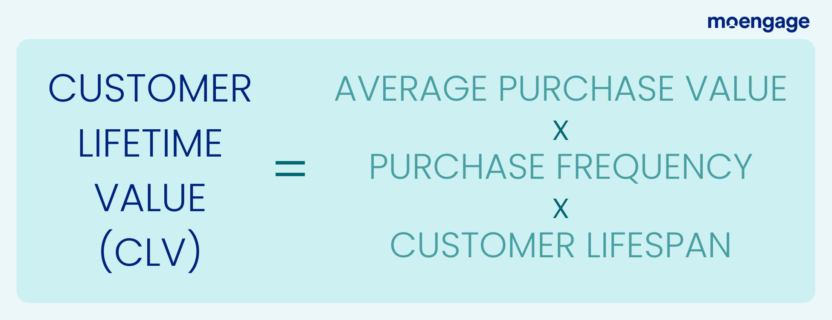
The customer lifetime value is an indicator of a customer’s total value to your company. Changes to this metric can indicate that you are being more (or less) successful in your personalization marketing efforts.
Balancing Data Privacy & Consumer Trust with Personalized Marketing
Data privacy has become a hot-button issue recently, and for good reason. Failure to keep customer data safe can put them at risk. It can also put your organization in danger and potentially harm your brand’s reputation, sometimes beyond repair.
Failure to meet data privacy requirements can also lead to severe penalties and fines, so it’s important to stay compliant with applicable laws and regulations.
Below, we cover five top tips for balancing data privacy and consumer trust with your personalized marketing strategy.
1. Adhere to Data Privacy Regulations
Meeting regulatory requirements for data privacy is imperative not just to keep customer data secure, but also because failure to do so comes with hefty fines. Regulations are different based on jurisdictions, so you’ll need to make sure you know which data privacy regulations apply based on where you operate. Common examples include the CCPA in California and the GDPR in the United Kingdom.
Even when not required, minimum data privacy standards are recommended to keep your customers safe and to avoid reputational damage.
2. Gain Proper Consent for Data Collection
Make sure your data privacy policies are clearly outlined and easily accessible. Collect necessary consent when collecting any data that requires permission. In general, it’s a good practice to collect only what’s necessary to avoid breaching any data collection, storage, or management complications.
3. Be Explicit and Transparent About Data Usage
Build consumer trust by being clear and direct about how you use customer data, and make this information readily accessible as part of your data privacy policies.
4. Provide Value and Relevance
Make sure that the data you’re collecting is being translated into meaningful value for your customers, enhancing their user experience and making it easier for them to shop (and buy) with your brand. The more useful and relevant the recommendations you provide, the more willing customers will be to share their data with you.
In fact, according to Statista data from 2023, 80% of consumers believe it’s appropriate for marketers to collect purchase history of their clients. As long as customers are getting real value by providing that data, the happier they’ll be.
5. Ensure Equality and Fairness
Personalization shouldn’t be exploitative, it should — and can — be fair, inclusive, and non-discriminatory. Address bias when developing personalization algorithms and train AI using diverse data sets. Regularly audit your system to ensure it’s providing equal opportunities for all customers.
Personalize End-to-End Marketing with MoEngage
MoEngage’s Customer Engagement Platform helps you leverage personalized marketing tactics at every touch point along the customer journey. Nurturing customers along the conversion funnel with personalized messaging, product recommendations, and advertisements leads to increased conversions.
But it goes beyond this. Deep, meaningful engagement leads to repeat sales and fosters unbreakable brand loyalty, increasing average order value, lifetime customer value, and overall revenue.
Schedule a demo today to learn how MoEngage can help you provide personalized product recommendations, content, messages, and advertisements that fuel engagement and increase sales.

